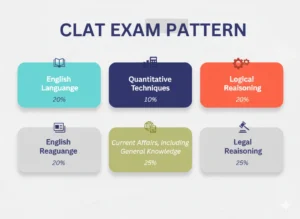The Consortium of National Law Universities (CNLU) has shared the updated CLAT 2026 exam pattern and syllabus on its official website. Last year, the CLAT UG exam pattern was changed, and now the same pattern will be followed in 2026 too. According to the new format, the CLAT UG exam will have 120 questions instead of 150. The exam will be held on 7th December 2025. It is very important for students to know the exam pattern before taking the test. This page includes the latest updates for both UG and PG CLAT exams.
CLAT 2026 Exam Pattern
The CLAT 2026 exam pattern aims to test students' ability to comprehend and apply knowledge effectively. Understanding the exam pattern helps students to make perfect strategies and maximize their scores. As an aspirant of the CLAT, you should have a better understanding of the exam pattern. That can help you make a strong strategy for your preparation, and make sure to attempt all five sections of the exam.
Check- CLAT Eligibility Criteria
CLAT Exam Format Overview
The CLAT exam will be conducted on 7 December 2025 in pen-and-paper mode. The exam pattern provides you with all the details about the exam. The following details give you a clear picture of the CLAT exam pattern, which can help in your preparation.
| Particulars | Details |
| Exam | CLAT UG |
| Exam Conducting Body | Consortium of National Law Universities (NLUs) |
| Mode of the exam | Offline, Pen-Paper mode |
| Number of Sections | 5 |
| Sections | English, legal reasoning, logical reasoning, general knowledge, and quantitative aptitude. |
| Total Number of Questions | 120 |
| Total Marks | 120 |
| Marking Scheme | +1 mark for wright answers -0.25 mark for wrong answers |
CLAT 2026 Exam: Section-Wise Questions
The CLAT UG 2026 paper is designed to assess reading, reasoning, analytical, and numerical abilities. The paper contains 120 multiple-choice questions for 120 marks. A clear understanding of the section-wise question distribution helps the students to divide the time for preparation and strategy of attempting questions on the exam day. The CLAT exam focused on reading and reasoning skills. Better performance in all 5 sections increases the chance of getting admission to top NLUs.
Check- CLAT Exam Date 2026
| Subjects | Questions (approx) |
| English Language | 20-25 Questions |
| General Knowledge & Current Affairs | 28-32 Questions |
| Legal Reasoning | 22-26 Questions |
| Logical Reasoning | 22-26 Questions |
| Quantitative Aptitude | 10-14 Questions |
CLAT Exam Pattern 2025: Subject-Wise Weightage

CLAT 2026: Marks Distribution
For effective preparation, aspirants should understand the CLAT 2026 section-wise marking distribution. Section-wise marking distribution highlights the weightage of each subject and helps the aspirants to allocate time according to the section. There is 1 mark for each question of each section. -0.25 is the negative marking for every wrong answer.
| Sections | Marking Distribution |
| English | 20-25 Marks |
| General Knowledge & Current Affairs | 28-32 Marks |
| Legal Reasoning | 22-26 Marks |
| Logical Reasoning | 22-26 Marks |
| Quantitative Aptitude | 10-14 Marks |
| Total | 120 Marks |
CLAT 2026 Exam: Subject-Wise Details
English: In this section, 20-26 questions are asked. The CLAT English language section asked questions in the form of a paragraph. Reading comprehension and vocabulary are asked in the exam; the difficulty level of this section is 12th level, but the question is tricky and is not directly asked in the exam.
Legal Reasoning: The Legal Reasoning section consists of 22-26. Topics are based on legal matters, philosophical inquiries, etc.
General Knowledge & Current Affairs: Almost 28-32 questions are asked in this section. General knowledge and current affairs questions are also based on a paragraph. The questions are based on static, national, and international news and other related topics that are in the news.
Logical Reasoning: In this section, there are a total of 22-26 questions. The question level of this section is easy to moderate.
Quantitative aptitude: This section carries only 10-14 questions in this exam. Questions are based on basic elementary mathematics, ratios, proportions, percentages, profit & loss, etc.
